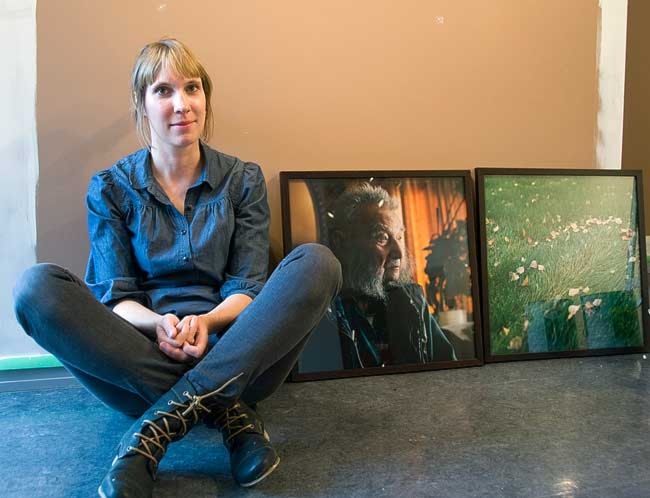Anyone walking through a back lot near Dawson City might come across a dog lying on the roof of its kennel. When Vancouver photographer Birthe Piontek focuses her lens on this simple image, though, she creates an image that ripples with tension.
The same can be said of her portraits of people: they feel like someone has hit the pause button on a narrative full of tension, or even malevolence. For example, an old man with unwieldy sideburns stares ahead of him. Nothing “happens” in the image, yet the backlit orange curtain edging the room behind him is an anxious, possibly threatening colour, like an uncontrolled fire.
Piontek spent August to October, 2008, in Dawson City as artist-in-resident with the Klondike Institute for Art and Culture (KIAC). She came with a fairly open-ended project.
“The way I work is with my guts, and when I went up to Dawson I had no idea what to expect,” she says. “I always had a project in mind to shoot in a small town somewhere, maybe to see how different that is compared to living in a city.”
Thursday night sees the result of that work, almost two years later, when she presents 20 images from her experience in an exhibition called The Idea of North at the ODD Gallery.
Previous works by Piontek, like her Sub Rosa series of teenagers in contemplative states, resonate for many viewers with David Lynch’s work. The comparison rises because her portraits present a dark psychology with a violent or disturbed undertone. And in fact, Piontek re-watched the Twin Peaks series while in Dawson, as the nights became longer. (She had watched “everything she could get her hands on” by Lynch, during her Masters of Fine Arts in Photography at the University of Essen, Germany.)
But Piontek points to Vancouver photographer Jeff Wall as the artist whose work gave her the biggest insight, years ago, into what kind of images she wanted to make.
Wall is known for his large-scale photographs that look as if they were captured “on the spot.” In fact, their composition borrows a lot from film in terms of how they are prepared. Each involves hours devoted to scouting location, hiring models and arranging all the tiniest details, from clothing to lighting.
At first Piontek thought Wall photographed scenes exactly the way he found them. When she learned about his process, she was excited. “It was like, wait a second, that means that I don’t have to wait for the picture to happen,” she says. “It means I can create the picture and choose my accessories; choose my people I want to work with; choose my location and light. And it doesn’t have to be hard-core documentary - it can be more closely suited to my ideas and what I want to say.”
The New York Times Magazine and other publications regularly hire Piontek for editorial photography work. The National Film Board of Canada approached her about making a documentary of the Yukon, but she didn’t want to “put herself aside” that way, she says.
Instead, she developed friendships with Dawson residents, shot more than 200 rolls of 12-exposure film, and brought the undeveloped images back to Vancouver to let them sit for several months.
Then came news Piontek had been nominated for the Santa Fe Prize for Photography, an international competition. Needing new work for the committee, she developed the more than 2,000 photographs - and edited them down to only 40 images.
In this context, editing photographs isn’t about changing their appearance. It means taking time to see, slowly, how subtle layers of thought and connection appear between images, as well as within them.
“I show people contact sheets of my images and they can’t tell the difference between the one I choose and the one I don’t,” Piontek realizes.
The title for the exhibit - The Idea of North - also came through for her during the editing. It’s taken from Glenn Gould’s 1967 CBC radio documentary of the same name. During Piontek’s residency, video artist Charles Stankieviech introduced her to the work.
“I was listening to it again when I was researching for my artist statement,” Piontek says. “Part of what Gould says is that you come North with the idea of trying to be an insider, but you’re not really because you eventually return South. And that resonated for me.”
The Idea of North exhibits at the ODD Gallery from June 25 - July 30, 2010, with an artist talk and opening reception on Thursday July 24 at 7 p.m.
Meg Walker is a freelance writer based in Dawson City.
